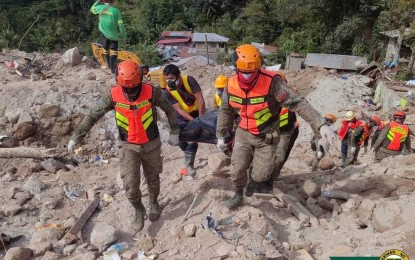
AFTERMATH. Philippine Army rescuers race against time to find survivors during search and rescue operations in landslide-hit Barangay Masara, Maco, Davao de Oro on Feb. 10, 2024. The NDRRMC has amended the guidelines on access to the NDRRM Fund for the repair, reconstruction, and rehabilitation of infrastructure in disaster-stricken areas. (Photo courtesy of the Philippine Army)
MANILA – The National Disaster Risk Reduction and Management Council (NDRRMC) has adopted a resolution amending the guidelines on access to the NDRRM Fund for the repair, reconstruction, and rehabilitation of infrastructure in disaster-stricken areas.
The measure was tackled during Tuesday's emergency full council meeting presided over by NDRRMC chair and Defense Secretary Gilberto Teodoro Jr., the agency said in a news release.
The council tackled the amendments that seek to expand the access of the local government units (LGUs) to the NDRRM Fund.
The resolution revokes the guidelines specified in the NDRRMC Memorandum Circular No. 1 series of 2024 that prioritize only the 4th to 6th income class LGUs and require 1st to 3rd income class LGUs for a local counterpart fund.
The resolution stated that the “NDRRM Fund may be utilized to repair, reconstruct or rehabilitate local or national infrastructure regardless of income classification when such are vital for access and connectivity and are necessary for response or early recovery as certified by the Regional Directors of the OCD (Office of Civil Defense) and the DPWH (Department of Public Works and Highways) in disaster-affected regions.”
Meanwhile, the local counterpart fund refers to the portion of the approved requested fund that the LGUs must shoulder depending on their income class.
With the adoption of the resolution, the counterpart funding requirement is now repealed.
Under Section 22 of the Republic Act 10121 or the Philippine Disaster Risk Reduction and Management Act of 2010, the “National DRRM Fund shall also be utilized for relief, recovery, reconstruction, and other work or services in connection with natural or human-induced calamities which occur during the budget year or those that occurred in the past two years from the budget year.”
In a Feb. 7 briefing on the effects of the northeast monsoon and trough of a low pressure area in Davao City, President Ferdinand R. Marcos Jr. directed various agencies to fast-track the repair of damaged infrastructure, especially those that are essential in response operations.
The NDRRMC, meanwhile, acknowledged that support from the national government is critical in ensuring the resilient recovery of disaster-affected areas, given the severe effects of disasters and the depletion of LGUs' limited resources. (PNA)
